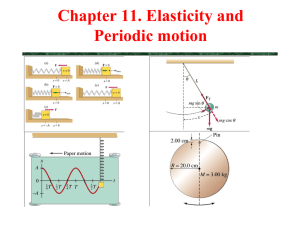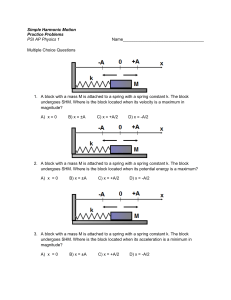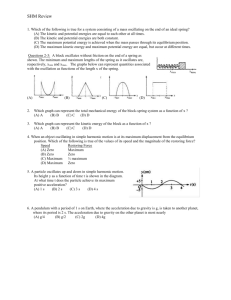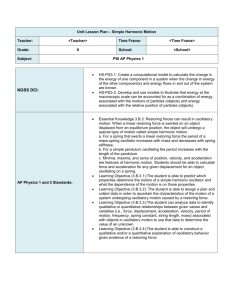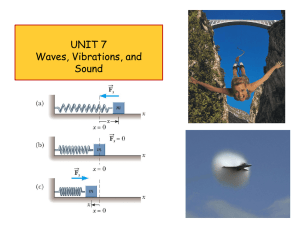AP Physics B/C
advertisement
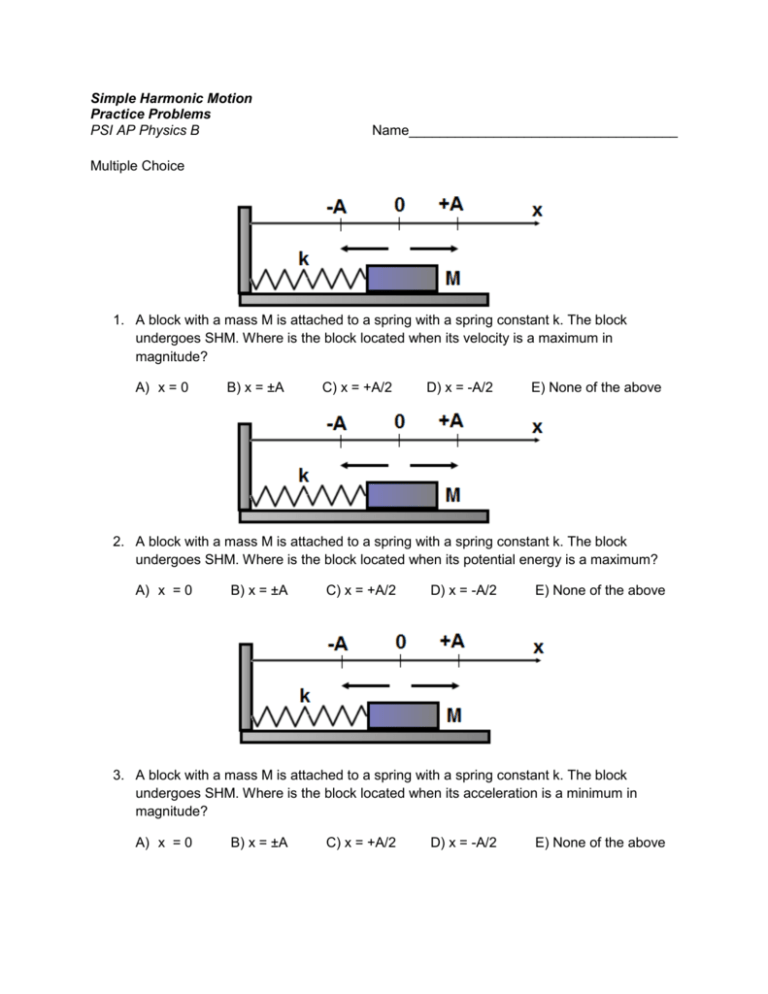
Simple Harmonic Motion Practice Problems PSI AP Physics B Name___________________________________ Multiple Choice 1. A block with a mass M is attached to a spring with a spring constant k. The block undergoes SHM. Where is the block located when its velocity is a maximum in magnitude? A) x = 0 B) x = ±A C) x = +A/2 D) x = -A/2 E) None of the above 2. A block with a mass M is attached to a spring with a spring constant k. The block undergoes SHM. Where is the block located when its potential energy is a maximum? A) x = 0 B) x = ±A C) x = +A/2 D) x = -A/2 E) None of the above 3. A block with a mass M is attached to a spring with a spring constant k. The block undergoes SHM. Where is the block located when its acceleration is a minimum in magnitude? A) x = 0 B) x = ±A C) x = +A/2 D) x = -A/2 E) None of the above 4. A mass-spring oscillating system undergoes SHM with a period T. What is the period of the system if the amplitude is doubled? A) 2T B) 4T C) T D) 1/2T E) 1/4T 5. A mass-spring oscillating system undergoes SHM with a period T when it is located on Earth. What is the period of the system when it is located on Moon? A) 6T B) T/6 C) D) T E) T 6. A block with a mass M is attached to a vertical spring with a spring constant k. When the block is displaced from equilibrium and released its period is T. A second identical spring k is added to the first spring in parallel. What is the period of oscillations when the block is suspended from two springs? A) 2T B) 4T C) T D) E) T 7. Two oscillating systems: spring-mass and simple pendulum undergo SHM with an identical period T. If the mass in each system is doubled which of the following is true about the new period? Mass-spring A) B) C) D) E) Simple pendulum 8. An object undergoes SHM and position as a function of time is presented by the following formula: x= (0.1 m) Sin (4πt). What is the period of oscillations? A) 2 s B) 1 s C) 0.5 s D) 0.1 s E) 4 s 9. An object undergoes SHM and position as a function of time is presented by the following formula: x= (0.5 m) Cos (πt). What is the amplitude of oscillations? A) 2 m B) 1 m C) 0.5 m D) 0.1 m E) 4 m 10. The position as a function of time of a mass-spring oscillating system is presented by the graph. Which of the following is true about velocity and acceleration at the time 1.5 s? Velocity Acceleration A) v >0 a<0 B) v = 0 a=0 C) v =0 a>0 D) v >0 a=0 E) v < 0 a=0 11. A particle undergoes SHM represented by the graph. Which of the following is true about the amplitude and period of oscillations? Amplitude Period A) 1 m 0.1 s B) 2 m 0.5 s C) 1 m 0.6 s D) 1 m 0.8 s E) 2 m 0.4 s 12. An object oscillates at the end of a spring. The position as a function of time is presented by the graph. Which of the following formulas represent the position and velocity of the object? Position Velocity A) x = (0.5) Sin(πt) v = (0.5π) Sin(πt) B) x = (0.5) Sin(πt) v = (0.5π) Cos(πt) C) x = (0.5) Cos(πt) v = (0.5π) Sin(πt) D) x = (0.5π) Sin(πt) v = (0.5) Sin(πt) E) x = (0.5) Cos(πt) v = (0.5π) Cos(πt) 13. A simple pendulum oscillates with a period T. If the mass of the pendulum is doubled what is the new period of the pendulum? A) T/2 B) 2T C) T D) T E) 14. A simple pendulum oscillates with a period T. If the length of the pendulum is doubled what is the new period of the pendulum? A) T/2 B) 2T C) T D) T E) 15. What is the length of a simple pendulum if it oscillates with a period of 2 s? A) 2.0 m B) 1.0 m C) 0.5 m D) 0.4 m E) 0.1 m 16. A simple pendulum consists of a mass M attached to a vertical string L. When the string is displaced to the right the ball moves up by a distance 0.2 m. When the ball is released from rest what is the maximum speed? A) 1 m/s B) 2 m/s C) 3 m/s D) 4 m/s E) 5 m/s 17. A simple pendulum consists of a mass M attached to a vertical string L. The string is displaced to the right by an angle ϴ. When the pendulum is released from rest what is the speed of the ball at the lowest point? A) 2 gL B) C) D) E) 18. A block of mass M is attached to a horizontal spring k. The block undergoes SHM with amplitude of A. Which of the following graphs represents the elastic potential energy as a function of position x? A) C) E) B) D) 19. A block of mass M is attached to a horizontal spring k. The block undergoes SHM with amplitude of A. Which of the following graphs represents the kinetic energy as a function of position x? A) C) E) B) D) 20. A 0.9 kg block is attached to an unstretched spring with a spring constant of 10 N/m. The block is released from rest. How long does it take for the block to return to its initial position? A) 0.3π s B) 0.5π s C) 0.4π s D) 0.9π s E) 0.6π s Free Response Problems 1. A 0.4 kg object is attached to a horizontal spring undergoes SHM with the total energy of 0.2 J. The potential energy as a function of position presented by the graph below: a. What is the amplitude of oscillations? b. What is the spring constant? c. What is the kinetic energy of the system at point x = 2.5 cm? d. Indicate point or points where the kinetic energy equals the potential energy of the system. e. What is the maximum speed of the object? 2. A 0.2 kg object is attached to a horizontal spring undergoes SHM with the total energy of 0.4 J. The kinetic energy as a function of position presented by the graph below: a. What is the maximum displacement from equilibrium? b. What is the maximum speed of the object? c. What is the spring constant? d. Indicate point or points where the kinetic energy equals the potential energy of the system. e. What is the potential energy of the system at point x = 2 cm? 3. A 20 g piece of clay moving at a speed of 50 m/s strikes a 500 g pendulum bob at rest. The length of a string is 0.8 m. After the collision the clay-bob system starts to oscillate as a simple pendulum. a. What is the speed of the clay-bob system after the collision? b. What is the maximum angular displacement of the pendulum? c. What is the period of the clay-bob oscillating system? d. What is the total energy of the oscillating system? The pendulum bob makes one complete oscillation and the string breaks at the lowest point. e. What is the maximum horizontal distance of the bob when it strikes the floor 0.7 m below? 4. A small block moving with a constant speed v collides inelastically with a block M attached to one end of a spring k. The other end of the spring is connected to a stationary wall. Ignore friction between the blocks and the surface. a. What is the speed of the system of two blocks after the collision? b. What is amplitude of oscillations of the system of two blocks? c. What is the period of oscillations? d. What is the total energy of the oscillating system? Answer Key Multiple Choice 1. A 2. B 3. A 4. C 5. E 6. D 7. D 8. C 9. C 10. D 11. D 12. B 13. C 14. D 15. B 16. B 17. D 18. A 19. B 20. A Free Response 1. a. 5 cm b. 160 N/m c. 0.15 J d. Any point on the curve where the y-axis equals 0.1 J e. 1 m/s 2. a. 4 cm b. 2 m/s c. 500 N/m d. Any point on the curve where the y-axis equals 0.2 J e. 0.1 J 3. a. 2.0833 m/s b. 43.677O c. 1.795 s d. 1.089 J e. 7.72 m 4. a. b. c. d.
